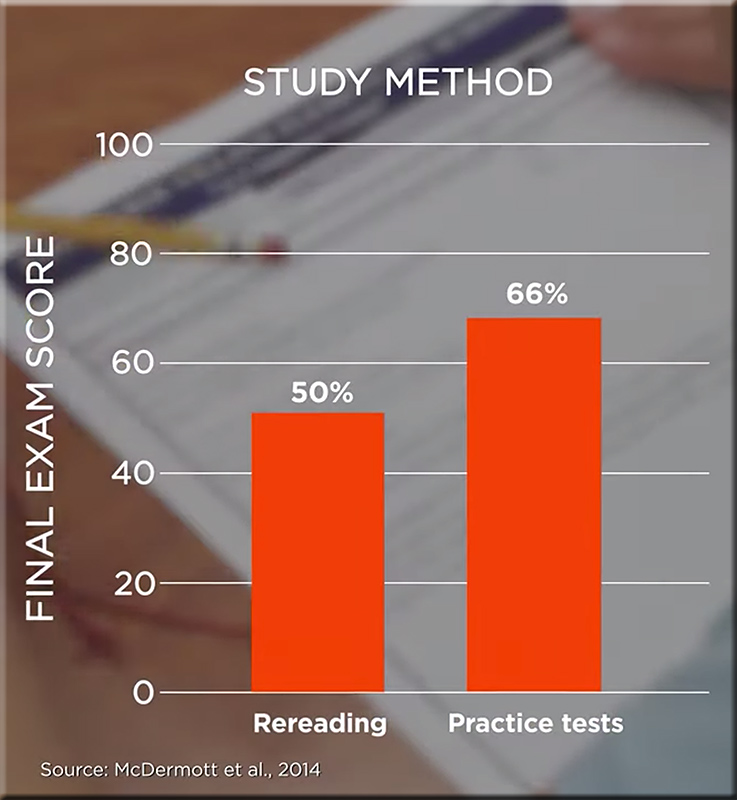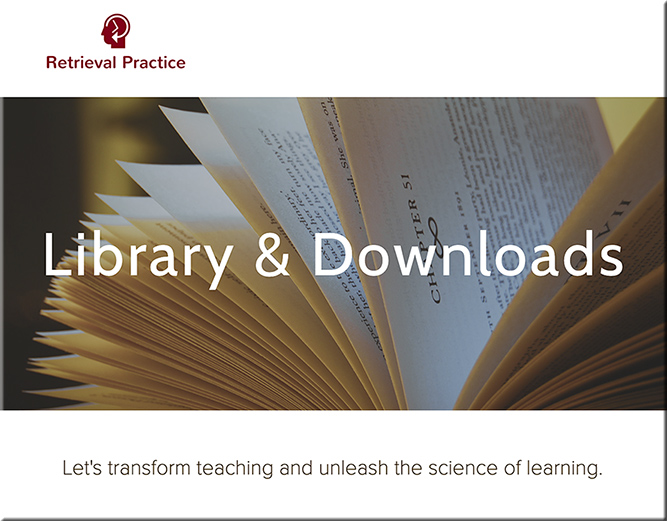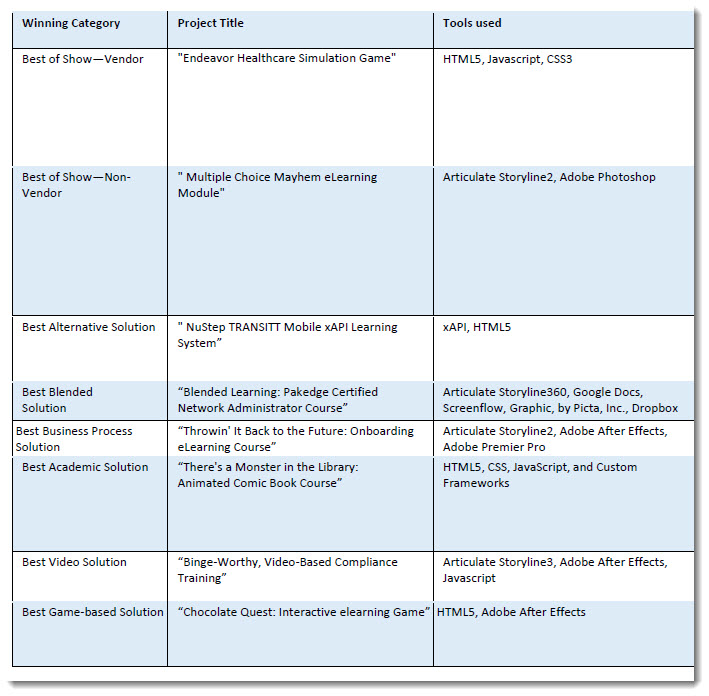Revised Bloom’s Taxonomy — from Iowa State University; with a shout out to Matt Miller for his blog posting entitled, “10 tips for lesson planning writer’s block” — where I saw this reference
Making (low-stakes) practice tests more effective — from edutopia.org
Practice tests not only help surface gaps in knowledge—they also strengthen memory.
The inaugural winners of Training Magazine’s Network Choice Awards — from trainingmag.com
Training magazine reveals the winners of its inaugural crowd-sourced vendor awards program: the 2019 Training Magazine Network Choice Awards.
Categories include:
- Authoring Tools
- Custom Content/Program Development
- Gamification
- Learning Portal/Learning Management System (LMS)
- Measurement, Testing, and Assessment
On the care and handling of student ratings — from rtalbert.org by Robert Talbert
Student evaluations of teaching are not true evaluations. We should call them what they are — perception data — and use them accordingly.
Excerpts:
How to handle student perception data as a department
- Never use student perception data as the sole, or even the main source of information about a faculty member’s teaching. Teaching, as I said, is a wickedly complex problem. It simply cannot be reduced to a set of data, or in some cases to a single number. To get an accurate picture of faculty teaching, you need more than just student perceptions. Use faculty self-evaluations, peer evaluations via class visits, faculty-initiated data collected through pre- and post-testing… Insist on using multiple sources of data for faculty evaluations and make it easy to include them.
- Never compare one faculty member to another based on student perception data.
- Look at trends over time and how faculty respond to their data.
Free downloads to transform your teaching & unleash the science of learning! [RetrievalPractice.org]
Per RetrievalPractice.org:
Download ALL our free guides, research, and resources!
We’re here to make your life easier. In order to unleash the science of learning, we strive to make it easy to access and quick to implement.
That’s why we really want you to download everything from our library, including free practice guides, book club resources, research, and more.
Colleges see equity success with adaptive learning systems — from edtechmagazine.com by Shailaja Neelakantan
Powered by advanced algorithms, adaptive learning technologies boost completion rates and give students confidence.
“I used to teach one class of 100 students, but now I teach 100 classes of one student each,” said Doug Williams, the adaptive learning coordinator at Arizona State University, in the white paper, describing the effect of using such a technology-driven system to improve learning outcomes.
From DSC:
I post this item because I believe that this is the type of thing that will be a piece of our future learning ecosystems. Learning agents. Systems that accommodate each individual’s learning preferences. Real-time formative assessments…that impact what you see and experience next. Intelligent systems. Intelligent tutoring.
People demonstrate mastery at different times — let that be part of our futures — versus this one-size fits all, hop-on-board-or-you-miss-the-train…a train that stops for no one.
A quick tip from RetrievalPractice.org’s e-newsletter today:
Can’t remember how a lesson from last semester or last year went? On the bottom or back of a lesson plan, include two questions:
Four research-based strategies every teacher should be using — from cultofpedagogy.com by Jennifer Gonzalez
Excerpt (emphasis DSC):
[Per Jennifer] Cognitive scientist Pooja Agarwal and K-12 teacher Patrice Bain have collaborated on a new book, Powerful Teaching: Unleash the Science of Learning. In the book, they go into detail about what it looks like when we actually apply four research-based “Power Tools” in the classroom: retrieval practice, spaced practice, interleaving, and feedback-driven metacognition—which is one we haven’t covered at all on this podcast. Today I’m going to talk with Pooja and Patrice about these strategies, the research behind why they work, and some ways you can start using them right away in your instruction.
Instead of assigning homework to give students practice with course material, give mini-quizzes at the start of each class that ask 3-5 questions about the prior day’s learning. These should either receive no grades or be given a very low point value, because the goal of these is to reinforce the learning, not measure or grade student work.
In her social studies classroom, Bain used to assign homework most nights, and found that not only was she spending up to two hours a night grading it, it also was doing nothing to help students retain information.
Belief in Learning Styles Myth May Be Detrimental — from apa.org
Many people believe learning styles predict academic and career success, study finds
Excerpts:
WASHINGTON — Many people, including educators, believe learning styles are set at birth and predict both academic and career success even though there is no scientific evidence to support this common myth, according to new research published by the American Psychological Association.
…
Previous surveys in the United States and other industrialized countries across the world have shown that 80% to 95% of people believe in learning styles. It’s difficult to say how that myth became so widespread, Nancekivell said.
Also see:
- Maybe They’re Born With It, or Maybe It’s Experience: Toward a Deeper Understanding of the Learning Style Myth — from apa.org by Shaylene E. Nancekivell, Priti Shah, and Susan A. Gelman
. - Learning Styles are NOT an Effective Guide for Learning Design — from debunker.club
Excerpt:
The strength of evidence against the use of learning styles is very strong. To put it simply, using learning styles to design or deploy learning is not likely to lead to improved learning effectiveness. While it may be true that learners have different learning preferences, those preference are not likely to be a good guide for learning. The bottom line is that when we design learning, there are far better heuristics to use than learning styles.
. - Learning styles: Worth our time? — from Cathy Moore
. - Learning Styles Debunked: There is No Evidence Supporting Auditory and Visual Learning, Psychologists Say — from psychologicalscience.org
. - Learning Styles FAQ — by Daniel Willingham
Excerpt:
How can you not believe that that people learn differently? Isn’t it obvious?
People do learn differently, but I think it is very important to say exactly how they learn differently, and focus our attention on those differences that really matter. If learning styles were obviously right it would be easy to observe evidence for them in experiments. Yet there is no supporting evidence. There are differences among kids that both seem obvious to us and for which evidence is easily obtained in experiments, e.g., that people differ in their interests, that students vary in how much they think of schoolwork as part of their identity (“I’m the kind of kid who works hard in school”) and that kids differ in what they already know at the start of a lesson. All three of these have sizable, easily observed effects on learning. I think that often when people believe that they observe obvious evidence for learning styles, they are mistaking it for ability.
From DSC:
While I’ve heard and read through the years that there isn’t support for learning styles — and I’ve come to adopt that perspective as well due to what I’ve read, such as the items listed above — I do think that each of us has our learning preferences (as the debunker club mentioned as well). That is, how we prefer to learn about a new subject:
- Some people like to read the manual.
- Others never pick up the manual…they prefer to use the trial and error / hands-on method.
- Some people prefer to listen to audio books.
- Others prefer to watch videos.
- Others like to read about a new topic.
- Others like to study in a very quiet place — while others prefer some background noise.
- Some people love to learn in a 100% online-based mode…some people hate it, and that delivery method doesn’t work as well for them.
Along these lines…in my mind, offering learning in multiple media and in multiple ways maximizes the enjoyment of learning by a group of people. And now that we’re all into lifelong learning, the enjoyment of learning has notched waaay up in importance in my book. The more we enjoy learning, the more we enjoy life (and vice versa).
In fact, I’m getting closer to the point of putting enjoyment of learning over grades in terms of importance. Grades are a way to compare people/school systems/colleges/universities/etcetera…they are the currency of our current systems…and they are used to “incentivize” students. But such systems and methods often produce game players, not learners.
5 Research-Backed Studying Techniques — from edutopia.org by Edward Kang
Teachers can guide students to avoid ineffective studying habits in favor of ones that will increase their learning outcomes.
Excerpts:
Ineffective techniques include:
- Studying for long periods of time
- Studying a single subject for a long period of time and repeating phrases over and over to memorize them (known as massed practice)
- Reviewing one topic repeatedly before moving onto another topic (blocked practice)
- Reading and rereading a text
- Highlighting or underlining important concepts in a text and then reviewing
- Reviewing notes
The book Make It Stick identifies several research-proven studying techniques.
- Pre-test
- Spaced practice
- Self-quizzing
- Interleaving practice
- Paraphrasing and reflecting
From DSC:
Re: the Learning from the Living [Class] Room vision of a next gen learning platform…
…wouldn’t it be cool if you could use your voice to ask your smart/connected “TV” type of device:
“Show me the test questions for Torts I from WMU-Cooley Law School. Cooley could then charge $0.99 for these questions.”
Then, the system knows how you did on answering those questions. The ones you got right, you don’t get asked to review as often as the ones you got wrong. As you get a question right more often, the less you are asked to answer it.
You sign up for such streams of content — and the system assesses you periodically. This helps a person keep certain topics/information fresh in their memory. This type of learning method would be incredibly helpful for students trying to pass the Bar or other types of large/summative tests — especially when a student has to be able to recall information that they learned over the last 3-5 years.
Come to think of it…this method could help all of us in learning new disciplines/topics throughout our lifetimes. Sign up for the streams of content that you want to learn more about…and drop the (no-longer relevant) subscriptions as needed..

From DSC:
Pastors, what do you think of these ideas?
- Summarize your key points and put them up on slides at the end of your sermons (and/or at discussion groups after service)
- Summarize your key points and post them to the churches’ websites — including links to resources that you referenced in your sermons (books, devotions, other)
- Have an app that folks in your congregation could complete during the sermon (like “fill in the blanks” / missing words or phrases). Or, if you’d prefer that your congregation not have their smartphones out, perhaps you could provide “quizzes” mid-week to assist in information recall (i.e., spaced repetition). That is, people would need to try to fill in the missing phrases and/or words mid-week. Answers would be immediately available if someone asked for them.
Along these lines…should there be more classes in seminary on learning theories and on pedagogy? Hmmm….an interesting thought.
Three ways to use video feedback to enhance student engagement — from scholarlyteacher.com by Christopher Penna
Excerpt:
An innovative approach for providing feedback on student work in a variety of disciplines is the use of screen capture videos (Mathisen). These videos allow for the recording of what is on the instructor’s screen (for example, a student paper) accompanied by audio narration describing strengths and weaknesses of the work being discussed as well as any edits that the instructor is making on the page. Once created, the video is available to the student for repeated viewing. Research indicates these videos provide more concrete and effective guidance for students and a higher level of student engagement than traditional written comments and rubrics (Jones, Georghiades, & Gunson, 2012; Thompson & Lee, 2012).
















